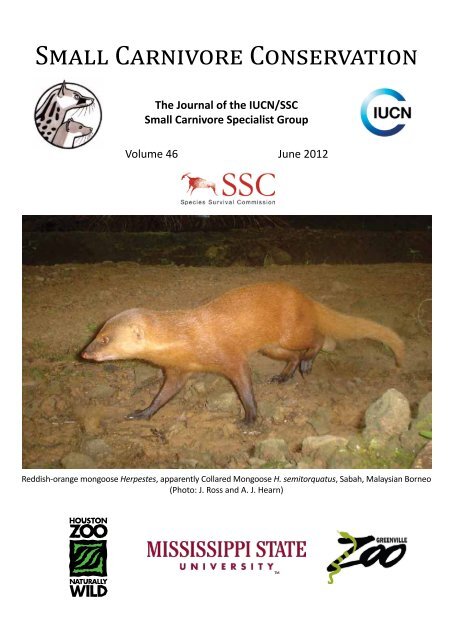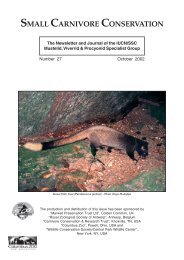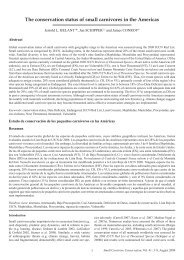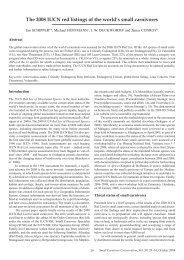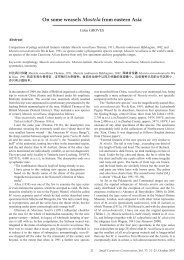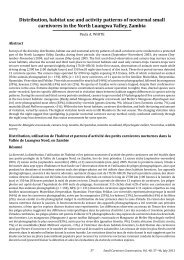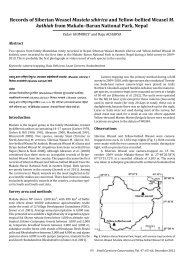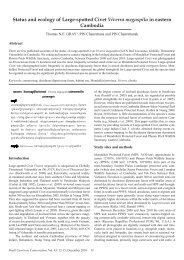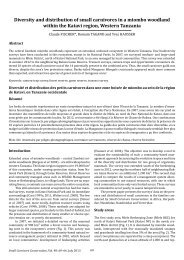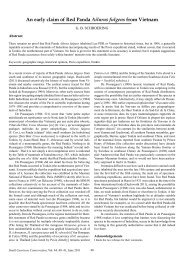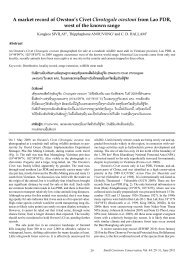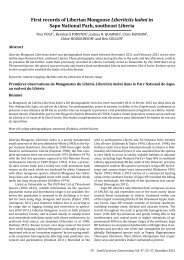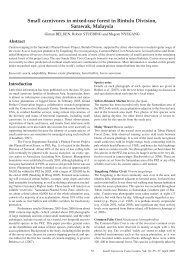PDF - Small Carnivore Conservation
PDF - Small Carnivore Conservation
PDF - Small Carnivore Conservation
You also want an ePaper? Increase the reach of your titles
YUMPU automatically turns print PDFs into web optimized ePapers that Google loves.
<strong>Small</strong> <strong>Carnivore</strong> <strong>Conservation</strong><br />
The Journal of the IUCN/SSC<br />
<strong>Small</strong> <strong>Carnivore</strong> Specialist Group<br />
Volume 46 June 2012<br />
Reddish-orange mongoose Herpestes, apparently Collared Mongoose H. semitorquatus, Sabah, Malaysian Borneo<br />
(Photo: J. Ross and A. J. Hearn)
The occurrence of reddish-orange mongooses Herpestes<br />
in the Greater Sundas and the potential for their field confusion<br />
with Malay Weasel Mustela nudipes<br />
J. ROSS 1 , E. GEMITA 2 , A. J. HEARN 1 and D. W. Macdonald 1<br />
Abstract<br />
Five recent camera-trap records of mongooses Herpestes from two different survey areas in Sabah, Malaysian Borneo, show<br />
strongly reddish-orange pelage. These animals otherwise resemble Collared Mongoose H. semitorquatus, and appear to represent<br />
colour variation within this species. Collared Mongooses of typical mahogany-brown colour and with pelage of intermediate<br />
colour were also recorded, as were Short-tailed Mongooses H. brachyurus. A single photograph of a similarly bright reddishorange<br />
mongoose was taken in Harapan Rainforest, Sumatra, Indonesia. This coloration is relatively rare within the Collared<br />
Mongoose population of Borneo; it may predominate in Sumatra. It is a hitherto unappreciated identification pitfall for Malay<br />
Weasel Mustela nudipes, itself more variable in pelage colour than is popularly appreciated.<br />
Keywords: Borneo, Collared Mongoose, field identification, Herpestes semitorquatus, pelage variation, Sumatra<br />
Kejadian kemerah jinggan pada mongooses di Greater Sunda dan potensi kekeliruan di lapangan<br />
dengan Malay Weasel Mustela nudipes<br />
Abstrak<br />
Lima rekod perangkap kamera terkini tentang mongooses Herpestes daripada dua kawasan tinjauan di Sabah, Malaysia Borneo,<br />
menunjukan warna bulu kemerah jinggan yang sangat ketara. Binatang ini adalah sangat serupa dengan Bambun ekor panjang<br />
(Collared Mongooses H. semitorquatus), dan muncul mewakili variasi warna dalam spesis ini. Bambun ekor panjang (Collared<br />
Mongooses) dan Bambun ekor pendek (Short-tailed Mongooses H. brachyurus) yang biasanya berwarna mahogany coklat, dan<br />
dengan warna bulu perantaraan juga direkodkan. Satu rekod bergambar mongooses yang mempunyai warna bulu kemerah<br />
jinggan juga didapati di Hutan hujan Harapan, Sumatra, Indonesia. Perwarnaan seperti ini relatifnya jarang berlaku di dalam<br />
populasi Bambun ekor panjang (Collared Mongoose) di Borneo, dan mungkin predominan di Sumatra. Sehingga sekarang ia sukar<br />
dikenali kerana salah pengecaman dengan Pulasan Tanah (Malay Weasel Mustela nudipes), kerana ia berbeza dalam warna<br />
bulu daripada apa yang selalu dikenali.<br />
Kata kunci: Borneo, Collared Mongoose, pengecaman lapangan, Herpestes semitorquatus, variasi bulu, Sumatra<br />
Ongoing camera-trap surveys of AJH, JR and DWM of seven<br />
forest areas and two oil palm plantations in Sabah, Malaysian<br />
Borneo, have accumulated over 30,000 trap-nights and over<br />
11,000 photographic captures of 22 carnivore species. These<br />
surveys have generated five independent photographic records<br />
of mongooses showing markedly reddish-orange pelage<br />
from two contiguous survey areas, Ulu Segama Forest Reserve<br />
and Danum Palm oil palm plantation (Table 1; Fig. 1). Such<br />
animals are not mentioned in the standard mammal identification<br />
guide for Borneo, Payne et al. (1985). A full compilation<br />
of our records of reddish-orange mongooses is in preparation.<br />
Ideally, a later analysis will also include a comprehensive review<br />
of museum specimens. This interim note draws attention<br />
to the existence of these animals, to (1) appeal for other relevant<br />
records, (2) assist those who may currently be in a position<br />
to review museum specimens, and (3) highlight the risk of<br />
confusion with Malay Weasel Mustela nudipes.<br />
An example of this reddish-orange coloration is shown in<br />
Fig. 2, photographed in the Danum Palm Estate (5°04'31.5"N,<br />
117°45'19.7"E; measured altitude 263 m) on 7 May 2009 at<br />
09h44. This animal closely resembles typical Collared Mon-<br />
gooses Herpestes semitorquatus (Fig. 3) in its general proportions<br />
and other characters, such as the pale neck-stripe, as<br />
do all photographs of reddish-orange mongooses from these<br />
surveys (e.g. photograph on front cover). In these characters,<br />
they differ markedly from the only other mongoose native<br />
to Borneo, Short-tailed Mongoose H. brachyurus, which additionally<br />
is even less warm brown in pelage than are typical<br />
Collared Mongooses (Fig. 4). A total of 86 independent detections<br />
(one record per camera site, per hour) of Collared Mongoose<br />
showing typical brown or reddish-brown pelage were<br />
recorded during these nine surveys, highlighting the relative<br />
rarity of the orange-coloured animals. These compare with<br />
230 independent detections of Short-tailed Mongoose, and<br />
while slight variation was noted within the latter’s pelage, no<br />
extremes in coloration were recorded. An additional 61 independent<br />
records of mongooses, none showing the reddishorange<br />
coloration, could not be identified to species. Whilst<br />
the number of Collared Mongooses exhibiting the extreme<br />
reddish-orange coloration was limited to five (5.49%) records,<br />
significant variation in pelage coloration is present in typical<br />
animals, some being somewhat more red in tone, with darker,<br />
<strong>Small</strong> <strong>Carnivore</strong> <strong>Conservation</strong>, Vol. 46: 8–11, June 2012<br />
8
Mongoose and Malay Weasel colour variation<br />
Fig. 1. Locations of the camera-trap survey areas in Borneo and Sumatra.<br />
Table 1. Locations, dates and times for each of the five photo captures of reddish-orange mongooses<br />
Herpestes in Sabah, Malaysia, showing the total number of photographs recorded per independent<br />
occasion.<br />
Study area Location Date Time Total n°<br />
photos<br />
Ulu Segama F.R. 4°57'03.1"N, 117°53'20.9"E 19 Sep 2007 15h52 1<br />
Danum Palm Estate 5°04'58.6"N, 117°45'32.7"E 1 Apr 2009 17h34 1<br />
Danum Palm Estate 5°05'03.3"N, 117°46'29.0"E 23 Apr 2009 07h34 1<br />
Danum Palm Estate 5°04'31.5"N, 117°45'19.7"E 7 May 2009 09h44 4<br />
Danum Palm Estate 5°04'31.5"N, 117°45'19.7"E 22 Jun 2009 13h53 2<br />
grey-brown coloration dorsally and on the upper parts of their<br />
rear legs. Two such animals are shown, from Danum Palm Estate<br />
(5°04'20.4"N, 117°46'23.5"E; measured altitude 243 m)<br />
on 14 May 2009 at 18h04 (Fig. 5a) and from Danum Palm Estate<br />
(5°04'31.5"N, 117°45'19.7"E; measured altitude 263 m)<br />
on 26 March 2009 at 07h32 (Fig. 5b). This observed colour<br />
variation does not appear to be related to habitat; animals of<br />
typical pelage, reddish-orange ones and intermediates were<br />
all detected in both forest and oil palm habitat.<br />
Careful examination of the colour of the plants and other<br />
background in each relevant photograph indicates that these<br />
reddish-orange animals’ tones are real, and not simply the effects<br />
of lighting, or a malfunction of the camera which would<br />
cause the entire photograph to be peculiarly coloured. In addition,<br />
the same type of digital camera-trap (Snapshot Sniper<br />
P41, Snapshot Sniper LLC, OK, U.S.A.), which incorporates a<br />
relatively high quality Sony P41 digital camera, was used in<br />
all Sabah surveys where these animals were recorded, thus reducing<br />
potential colour bias resulting from the use of different<br />
photographic equipment. Due to this variation in typical Col-<br />
lared Mongoose pelage tone, and because the reddish-orange<br />
animals’ structure and pelage pattern do not differ notably<br />
from those of typical Collared Mongoose, it seems likely that<br />
they represent variation in that species’ pelage.<br />
A single orange mongoose has also been camera-trapped<br />
recently on Sumatra, Indonesia. A total of 2,059 trap-nights<br />
in the Harapan Rainforest in 2010 generated only four detections<br />
of mongooses. Three were typically coloured Short-tailed<br />
Mongooses but the other shows striking orange-coloured pelage<br />
and was taken in mixed lowland secondary forest with<br />
bamboo, near a river, on 29 December 2010 at 16h02 (Fig. 6;<br />
2°18'04.1"S, 103°12'54.4"E; 70 m measured altitude). This<br />
animal is also similar to Collared Mongoose in its proportions,<br />
notably in the long tail length relative to head and body, but on<br />
the single photograph available, the neck pattern is difficult to<br />
determine. There are few records of Collared Mongoose from<br />
Sumatra. Those in Jentink (1894; one animal) and Robinson &<br />
Kloss (1919; two animals) may be the only previously published<br />
ones; a recent trawl for records traced no others from<br />
the island (Jennings & Veron 2011). An anonymous reviewer of<br />
9<br />
<strong>Small</strong> <strong>Carnivore</strong> <strong>Conservation</strong>, Vol. 46, June 2012
Ross et al.<br />
the present text (in litt. 2012) pointed out that all these three<br />
specimens also are strikingly orange in colour. This Harapan<br />
animal’s proportions cannot be that of Short-tailed Mongoose,<br />
the sole mongoose widely and commonly recorded on Sumatra.<br />
The only other mongoose species collected on Sumatra is <strong>Small</strong><br />
Asian Mongoose H. javanicus, which may not be native there<br />
and is known by few records (Jennings & Veron 2011: 324):<br />
in relative proportion of head-and-body to tail length, it could<br />
arguably be the species camera-trapped at Harapan Rainforest.<br />
Thus, while this Harapan orange mongoose is also plausibly a<br />
Collared Mongoose, particularly given the striking orange-red<br />
coloration of all three Sumatran specimens about which we<br />
have information, it is best left presently unidentified.<br />
A recent review of the taxonomy of Asian Herpestes mongooses,<br />
including examination of Collared Mongoose specimens<br />
held at the Rijksmuseum voor Natuurlijke Historie (National<br />
Museum of Natural History, ‘Naturalis’), Leiden, Netherlands<br />
(RMNH) and the Natural History Museum, London, U.K. (Patou<br />
et al. 2009), did not discuss such wide intraspecific variation<br />
in pelage colour in any Sundaic mongoose, nor do the standard<br />
synthetic works covering these species such as Payne et al.<br />
(1985) and Corbet & Hill (1992). However, after examination of<br />
a Collared Mongoose specimen from Sumatra (RMNH 20803),<br />
Patou et al. (2009: 77) concluded that it was “clearly a red<br />
morph of H. semitorquatus”: this is the only published statement<br />
we have traced referring to this coloration in the species.<br />
In their description of Mungos [= Herpestes] semitorquatus unicolor,<br />
based on two specimens including that later examined<br />
by Patou et al. (2009), Robinson & Kloss (1919: 302) surprisingly<br />
did not note the taxon as being redder than the nominate<br />
(Bornean) form, focussing their attention on its lack of hair<br />
banding, and describing its overall colour as “Sanford’s Brown<br />
to Hazel”.<br />
We have not examined museum specimens and cannot<br />
therefore compare their pelage with the photographs here<br />
documented. However, this coloration in Bornean mongooses<br />
has been observed at least twice before, even if never preserved:<br />
Davies & Payne (1982: 153) wrote that a “viverrid<br />
[mongooses were then often seen as members of the Viverridae]<br />
which could not be identified as any known Sabah species<br />
(bigger and more red than the Malay Weasel) was seen in<br />
October 1980 active at 12:15 hours. This anomalous animal is<br />
perhaps [Hose’s Mongoose] Herpestes hosei”. J. Payne (in litt.<br />
2012) observed this animal on the east side of the Crocker<br />
Range, north-west of Tenom town, at about 1,700 feet above<br />
sea level in hill dipterocarp forest. Davies & Payne (1982: 152)<br />
also noted that “in 1966, Mr Tony Lamb . . . was given a reddish<br />
mongoose collected at Tangusu Bay between Segama Estuary<br />
and Tambisan”. That would be extreme lowland dipterocarp<br />
forest, maybe below 50 feet a.s.l., and was probably a logging<br />
area at the time, near swamp forest (J. Payne in litt. 2012). It<br />
seems highly likely that these animals were mongooses of the<br />
same type as here photographed; there is no need to invoke<br />
H. hosei, which is now generally considered a synonym of H.<br />
brachyurus (e.g. Corbet & Hill 1992, Patou et al. 2009).<br />
Pending specimen confirmation, the assignment of these<br />
reddish-orange animals to Collared Mongoose is provisional.<br />
While it might seem surprising that such distinct phenotypic<br />
variation should remain undocumented for so long on Borneo,<br />
Collared Mongoose is so poorly known overall that it is<br />
listed as Data Deficient by The IUCN Red List of Threatened<br />
Species (IUCN 2011). It has never been the subject of any field<br />
study and it is only through the increasing use of camera-traps<br />
throughout its range that this apparently rare coloration has<br />
been recorded recently.<br />
These mongooses pose a hitherto unappreciated identification<br />
risk with Malay Weasel. Although orange-red Collared<br />
Mongoose specimens collected a century ago are held in museum<br />
collections, the lack of explicit mention of them in standard<br />
identification sources is problematic given that most people<br />
making field identifications base these on the literature, and<br />
do not habitually visit skin collections to check all their identifications.<br />
Malay Weasel has conventionally been considered<br />
almost unmistakeable in the field, having been seen as the<br />
only bright-orange small carnivore in its range (Borneo, Sumatra<br />
and the Thai–Malay peninsula, but not Java; Duckworth<br />
et al. 2006); for example Duckworth et al. (2006: 3), reviewing<br />
records of the species, wrote that “being morphologically<br />
extremely distinctive (South-east Asia has no other whiteheaded<br />
bright orange mammal, let alone an obviously weaselshaped<br />
one), sight records from observers of known general<br />
reliability were considered acceptable.”. The present photographs<br />
clearly demonstrate that Malay Weasel is one of two<br />
orange small carnivores in the Sundaic subregion, at least on<br />
Borneo and Sumatra. Thus, its field identification needs considerably<br />
more care than was hitherto believed. Specifically,<br />
the Malay Weasel records compiled by Duckworth et al. (2006)<br />
should now be seen as provisional except where supported by<br />
specimens or publicly available photographs. It seems, however,<br />
unlikely that many past Malay Weasel records do in fact<br />
refer to orange mongooses, given the paucity of specimens of<br />
such mongooses in zoological collections (contrasting with<br />
the dozens of Malay Weasels) and the low proportion of orange<br />
specimens among the camera-trap photographs from<br />
these nine survey areas in Sabah. Nevertheless, there is now<br />
an added need to publish records of Malay Weasel that explicitly<br />
rule out mongooses from the identification.<br />
For observers familiar with both genera, and with a good<br />
view (in life or on a photograph) of the animal, there should<br />
be little difficulty in distinguishing Malay Weasels from orange<br />
mongooses because the animals are so different in morphology.<br />
Under less optimal views, or for less experienced people,<br />
the risk is real. For example, the Sumatran animal here figured<br />
was originally placed on the project’s web-site (Harapan Rainforest<br />
2011) as a Malay Weasel (this has now been corrected)<br />
where it was seen and cited as a valid record of Malay Weasel<br />
in a manuscript about Sundaic small carnivores (J. W. Duckworth<br />
in litt. 2012).<br />
Malay Weasels seem always to have a pale head and the tail<br />
often has a pale tip (Brongersma & Junge 1942), features not<br />
apparently shown by orange mongooses. However, Malay Weasel<br />
is extremely variable in pelage: Brongersma & Junge (1942:<br />
157) wrote that “when the two extremes of the series [that they<br />
examined] . . . are placed side by side, one would hardly believe<br />
that they belong to the same species”. Although all the specimens<br />
they studied had heads somewhat to markedly paler than<br />
the body (in extreme cases, whitish), it cannot be excluded that<br />
Malay Weasels with heads looking almost concolorous with<br />
their body under field conditions might occur. Fig. 7 exemplifies<br />
variation in the pelage of Malay Weasel, showing an animal with<br />
<strong>Small</strong> <strong>Carnivore</strong> <strong>Conservation</strong>, Vol. 46, June 2012<br />
10
Mongoose and Malay Weasel colour variation<br />
typical bright orange-coloured body and one with markedly<br />
browner pelage. These latter animals require particular care in<br />
identification as, similarly, do orange mongooses.<br />
Acknowledgements<br />
We thank Jeremy Holden, Andreas Wilting and Wong Siew Te for fruitful<br />
discussions regarding the identity of these orange mongooses, and<br />
Gono Semiadi, John Payne, Will Duckworth and an anonymous referee<br />
for further information. JR, AJH and DWM thank our local collaborators<br />
Dr Henry Bernard, Institute for Tropical Biology and <strong>Conservation</strong>,<br />
Universiti Malaysia Sabah, and Soffian Abu Bakar, Sabah Wildlife Department.<br />
We thank Yayasan Sabah, Sabah Wildlife Department, Sabah<br />
Forestry Department, Sabah Parks, Danum Valley Management Committee,<br />
FACE foundation, the State Secretary, the Sabah Chief Minister’s<br />
Department, and the Prime Minister’s Department (EPU) for permission<br />
to conduct research. These surveys were primarily funded by the<br />
U.K. Government’s Darwin Initiative and the Kaplan family. Additional<br />
funding was provided by the Clouded Leopard Project, Point Defiance<br />
Zoo and Aquarium, Felidae <strong>Conservation</strong> Fund, HGH Wills, International<br />
Trust for Nature <strong>Conservation</strong>, and Wild About Cats. EG thanks<br />
Wahyudin, Musadat, Chandra, Iwan and Sumarno for assistance in the<br />
field, and David Lee and Jeremy Lindsell for logistical assistance and<br />
scientific advice. The Harapan Rainforest Project is funded by the German<br />
Federal Ministry for the Environment, Nature <strong>Conservation</strong> and<br />
Nuclear Safety (KFW), and the U.K. Government’s Darwin Initiative. We<br />
thank Gilmoore Bolongon for the Malay translation.<br />
References<br />
Brongersma, L. D. & Junge, G. C. A. 1942. On the variation of Mustela<br />
nudipes. Zoologische Mededeelingen 23: 149–170.<br />
Corbet, G. B. & Hill, J. E. 1992. Mammals of the Indomalayan region:<br />
a systematic review. Natural History Museum Publications and<br />
Oxford University Press, London and Oxford, U.K.<br />
Davies, G. & Payne, J. 1982. A faunal survey of Sabah. World Wildlife<br />
Fund Malaysia (IUCN/WWF project n° 1692), Kuala Lumpur,<br />
Malaysia.<br />
Duckworth, J. W., Lee, B. P. Y.-H., Meijaard, E. & Meiri, S. 2006. The<br />
Malay Weasel Mustela nudipes: distribution, natural history and<br />
a global conservation status review. <strong>Small</strong> <strong>Carnivore</strong> <strong>Conservation</strong><br />
34&35: 2–21.<br />
Harapan Rainforest 2011. Spotted. . Downloaded on 1 April 2012.<br />
IUCN 2011. 2011.2 IUCN Red List of Threatened Species. . Downloaded on 16 February 2012.<br />
Jennings, A. P. & Veron, G. 2011. Predicted distributions and ecological<br />
niches of 8 civet and mongoose species in Southeast Asia.<br />
Journal of Mammalogy 92: 316–327.<br />
Jentink, F. A. 1894. On a specimen of Herpestes semitorquatus Gray<br />
from Sumatra. Notes from the Leiden Museum 16: 210.<br />
Patou, M.-L., Mclenachan, P. A., Morley, C. G., Couloux, A., Jennings,<br />
A. P. & Veron, G. 2009. Molecular phylogeny of the Herpestidae<br />
(Mammalia, Carnivora) with special emphasis on the Asian Herpestes.<br />
Molecular Phylogenetics and Evolution 53: 69–80.<br />
Payne, J., Francis, C. M. & Phillips, K. 1985. A field guide to the mammals<br />
of Borneo. The Sabah Society with World Wildlife Fund Malaysia,<br />
Kota Kinabalu and Kuala Lumpur, Malaysia.<br />
Robinson, H. C. & Kloss, C. B. 1919. On mammals, chiefly from Ophir<br />
district, West Sumatra, collected by Mr. E. Jacobson. Journal of<br />
the Federated Malay States Museums 7: 299–325.<br />
1<br />
Wildlife <strong>Conservation</strong> Research Unit (WildCRU),<br />
Department of Zoology, University of Oxford,<br />
The Recanati–Kaplan Centre, Tubney, Abingdon,<br />
OX13 5QL, U.K.<br />
Contact author email: joanna.ross@zoo.ox.ac.uk<br />
2<br />
PT Restorasi Ekosistem Indonesia (REKI),<br />
Riset and <strong>Conservation</strong> Department,<br />
Jalan. M. Sutoyo N° 48B, Telanai Pura – Jambi 36122,<br />
Sumatera, Indonesia.<br />
Captions to figures (on back cover):<br />
Fig. 2. Bright reddish-orange mongoose, apparently Collared Mongoose<br />
Herpestes semitorquatus. Photograph taken at Danum Palm Estate,<br />
Sabah, Malaysia, 7 May 2009.<br />
Fig. 3. Collared Mongooses Herpestes semitorquatus showing typical<br />
mahogany-brown pelage. Photograph (a) taken in Ulu Segama Forest<br />
Reserve, Sabah, Malaysia, on 20 July 2007, (b) taken in Danum Palm<br />
Estate, Sabah, Malaysia, on 30 April 2009.<br />
Fig. 4. Short-tailed Mongoose Herpestes brachyurus. Photograph taken<br />
in Danum Palm Estate, Sabah, Malaysia, 21 May 2009. Note body colour<br />
and overall grizzling of pelage.<br />
Fig. 5. Apparent Collared Mongooses Herpestes semitorquatus showing<br />
pelage tone brighter than typical mahogany-brown pelage. Photograph (a)<br />
from Danum Palm Estate, Sabah, Malaysia, on 14 May 2009, (b) also from<br />
Danum Palm Estate, on 26 March 2009.<br />
Fig. 6. Mongoose, potentially Collared Mongoose Herpestes semitorquatus,<br />
showing rich orange pelage; Harapan Rainforest, Sumatra, Indonesia, 29<br />
December 2010 (Elva Gemita / Harapan Rainforest).<br />
Fig. 7. Malay Weasel Mustela nudipes, (a) of typical coloration: note<br />
the various clear structural differences from mongooses Herpestes<br />
and the pale head. Photograph taken in Crocker Range National Park,<br />
Sabah, Malaysia, 4 November 2011. (b) showing a browner coloration,<br />
highlighting the potential for confusion with other species when<br />
identification is based on colour alone. Photograph taken in Crocker<br />
Range National Park, Sabah, Malaysia, on 1 February 2012.<br />
11<br />
<strong>Small</strong> <strong>Carnivore</strong> <strong>Conservation</strong>, Vol. 46, June 2012
2 3a<br />
3b 4<br />
H<br />
5a<br />
5b<br />
M<br />
6 7a 7b<br />
For details of the above pictures, refer Ross et al. page 11.<br />
ISSN 1019-5041


